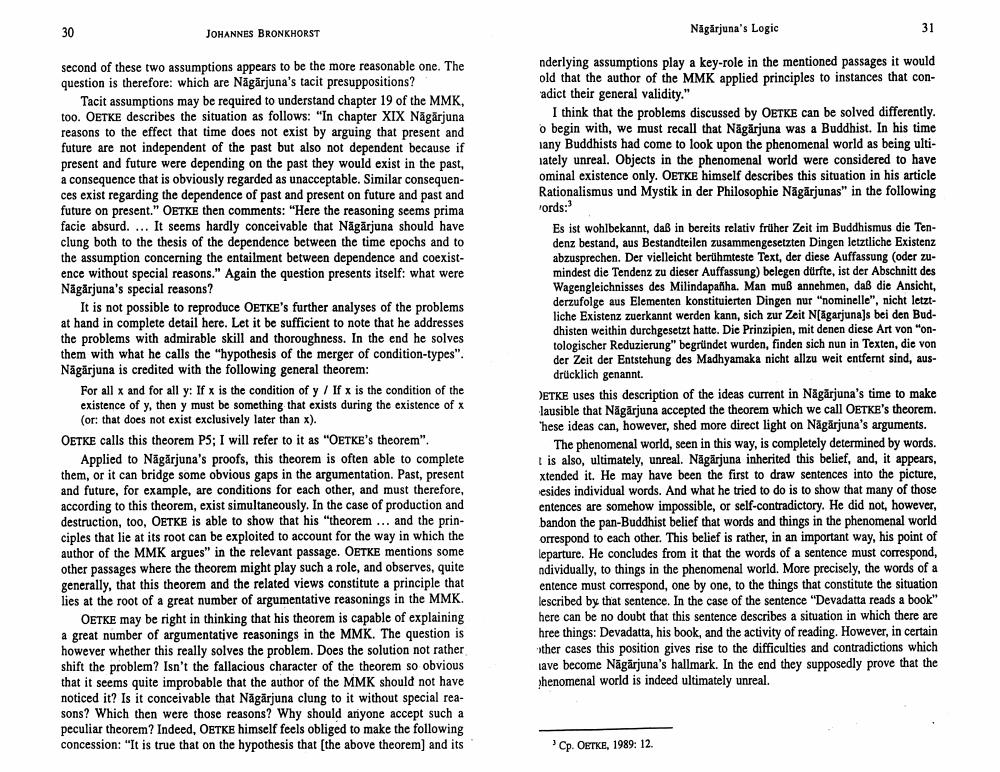Book Title: Nagarjuna Logic Author(s): Johannes Bronkhorst Publisher: Johannes Bronkhorst View full book textPage 2
________________ JOHANNES BRONKHORST Năgărjuna's Logic 31 second of these two assumptions appears to be the more reasonable one. The question is therefore: which are Nāgārjuna's tacit presuppositions? Tacit assumptions may be required to understand chapter 19 of the MMK, too. OETKE describes the situation as follows: "In chapter XIX Nāgārjuna reasons to the effect that time does not exist by arguing that present and are not independent of the past but also not dependent because if and future were depending on the past they would exist in the past, a consequence that is obviously regarded as unacceptable. Similar consequences exist regarding the dependence of past and present on future and past and future on present." OETKE then comments: "Here the reasoning seems prima facie absurd.... It seems hardly conceivable that Nägarjuna should have clung both to the thesis of the dependence between the time epochs and to the assumption concerning the entailment between dependence and coexistence without special reasons." Again the question presents itself: what were Nāgārjuna's special reasons? It is not possible to reproduce OETKE's further analyses of the problems at hand in complete detail here. Let it be sufficient to note that he addresses the problems with admirable skill and thoroughness. In the end he solves them with what he calls the "hypothesis of the merger of condition-types". Nägärjuna is credited with the following general theorem: For all x and for all y: If x is the condition of y/ If x is the condition of the existence of y, then y must be something that exists during the existence of X (or: that does not exist exclusively later than x). OETKE calls this theorem P5; I will refer to it as "OETKE's theorem". Applied to Nāgārjuna's proofs, this theorem is often able to complete them, or it can bridge some obvious gaps in the argumentation. Past, present and future, for example, are conditions for each other, and must therefore, according to this theorem, exist simultaneously. In the case of production and destruction, too, OETKE is able to show that his "theorem ... and the principles that lie at its root can be exploited to account for the way in which the author of the MMK argues" in the relevant passage. OETKE mentions some other passages where the theorem might play such a role, and observes, quite generally, that this theorem and the related views constitute a principle that lies at the root of a great number of argumentative reasonings in the MMK. OETKE may be right in thinking that his theorem is capable of explaining a great number of argumentative reasonings in the MMK. The question is however whether this really solves the problem. Does the solution not rather shift the problem? Isn't the fallacious character of the theorem so obvious that it seems quite improbable that the author of the MMK should not have noticed it? Is it conceivable that Nāgārjuna clung to it without special reasons? Which then were those reasons? Why should anyone accept such a peculiar theorem? Indeed, OETKE himself feels obliged to make the following concession: "It is true that on the hypothesis that the above theorem) and its nderlying assumptions play a key role in the mentioned passages it would old that the author of the MMK applied principles to instances that conadict their general validity." I think that the problems discussed by OETKE can be solved differently. o begin with, we must recall that Nāgārjuna was a Buddhist. In his time iany Buddhists had come to look upon the phenomenal world as being ultilately unreal. Objects in the phenomenal world were considered to have ominal existence only. OETKE himself describes this situation in his article Rationalismus und Mystik in der Philosophie Nāgārjunas" in the following 'ords: Es ist wohlbekannt, daß in bereits relativ früher Zeit im Buddhismus die Tendenz bestand, aus Bestandteilen zusammengesetzten Dingen letztliche Existenz abzusprechen. Der vielleicht berühmteste Text, der diese Auffassung (oder zumindest die Tendenz zu dieser Auffassung) belegen dürfte, ist der Abschnitt des Wagengleichnisses des Milindapafiha. Man muß annehmen, daß die Ansicht, derzufolge aus Elementen konstituierten Dingen nur "nominelle", nicht letztliche Existenz zuerkannt werden kann, sich zur Zeit N[Agarjuna)s bei den Buddhisten weithin durchgesetzt hatte. Die Prinzipien, mit denen diese Art von "ontologischer Reduzierung" begründet wurden, finden sich nun in Texten, die von der Zeit der Entstehung des Madhyamaka nicht allzu weit entfernt sind, aus drücklich genannt. DETKE uses this description of the ideas current in Năgărjuna's time to make lausible that Nagarjuna accepted the theorem which we call OETKE's theorem. These ideas can, however, shed more direct light on Nagarjuna's arguments. The phenomenal world, seen in this way, is completely determined by words. 1 is also, ultimately, unreal. Nāgārjuna inherited this belief, and, it appears, xtended it. He may have been the first to draw sentences into the picture, esides individual words. And what he tried to do is to show that many of those entences are somehow impossible, or self-contradictory. He did not, however, bandon the pan-Buddhist belief that words and things in the phenomenal world orrespond to each other. This belief is rather, in an important way, his point of leparture. He concludes from it that the words of a sentence must correspond, ndividually, to things in the phenomenal world. More precisely, the words of a entence must correspond, one by one, to the things that constitute the situation lescribed by that sentence. In the case of the sentence "Devadatta reads a book" here can be no doubt that this sentence describes a situation in which there are hree things: Devadatta, his book, and the activity of reading. However, in certain ther cases this position gives rise to the difficulties and contradictions which lave become Nāgārjuna's hallmark. In the end they supposedly prove that the phenomenal world is indeed ultimately unreal. Cp. OETKE, 1989: 12.Page Navigation
1 2 3 4 5
